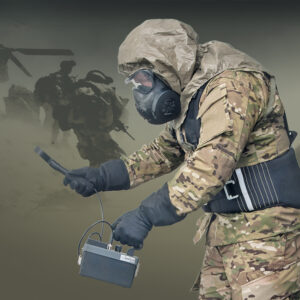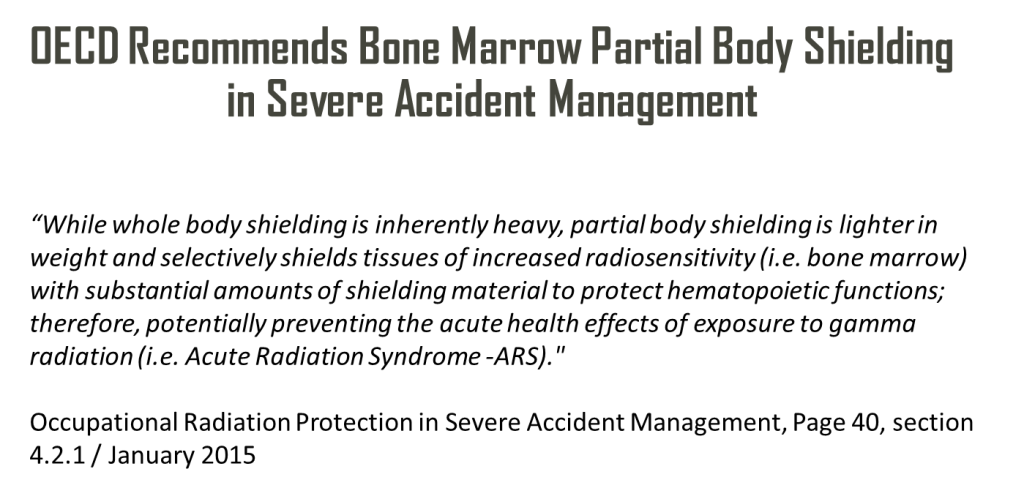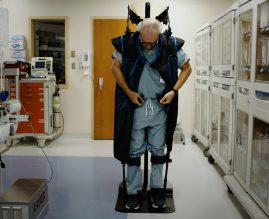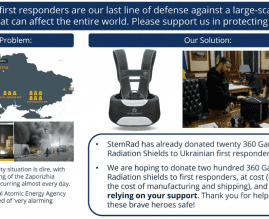Radiation PPE: Essential Protection in High-Risk Scenarios
11.29.23 | Wednesday | Jordan Houri, BSc, MSc
In a world where the threat of nuclear catastrophes and terrorist attacks on nuclear facilities looms large, the need for effective Radiation Personal Protective Equipment (Radiation PPE) has never been more critical.
The fallout from the Chernobyl disaster of 1986 is a clear reminder of the perils we face in the modern world. Such disasters are a real possibility, given an upsurge in global hostilities and terrorist activity. These increase the risks of exposure to lethal ionizing gamma radiation, endangering first responders and also civilians.
Discover the Future of Radiation Safety – Explore StemRad’s innovative solutions and understand how advanced Radiation PPE can redefine emergency response. Learn More
Securing Tomorrow: Unraveling the Dual Threats of Nuclear Terrorism and the Urgency for Advanced Radiation PPE Solutions
The historical context of nuclear power plant and weapon facility attacks reveals a two-pronged terrorist interest: obtaining radioactive material for weaponry and causing widespread devastation through core meltdowns or attacks on spent fuel pools.
Insider threats, external attacks, and cyber-attacks pose significant risks, underscoring the need for robust Radiation PPE solutions.
We know that the world is a hotbed of terror threats emerging from the Middle East, the Ukraine/Russia War, and well beyond. Terror groups, and their sponsors are fanning the flames, making it all the more important to stay protected with the best radiation PPE on the market.
360 Gamma Civilian Version Gamma Radiation Shield
Radiation PPE: Current Status and its role in Ensuring Safety
Nuclear disasters like Chernobyl and the threat of radiological attacks expose civilians and first responders to the deadly threat of ionizing gamma radiation. This invisible menace can trigger Acute Radiation Syndrome (ARS), a severe illness with potentially fatal consequences.
Current Personal Protective Equipment (PPE) for first responders falls short against this potent threat. Standard OSHA recommendations and guidelines, while emphasizing the ALARA principle (minimizing radiation exposure), fail to provide adequate protection during unavoidable exposure scenarios.
This gap creates a crucial need for innovative solutions. StemRad’s 360 Gamma radiation shield, a revolutionary vest targeting the bone marrow’s “stem cell niche” – the very source of blood cell production. By shielding this vital area, the 360 Gamma significantly boosts survivability against lethal doses of radiation.
Government agencies like HHS and OSHA, while offering general radiation response recommendations, acknowledge the limitations of existing PPE. They recognize the inadequacy of standard equipment against high-energy gamma rays, leaving critical first responders vulnerable.
Therefore, promoting the adoption of StemRad’s 360 Gamma becomes a pivotal policy priority. Mandating its use equips first responders with the protection needed to effectively contain radiation emergencies and save lives, even in high-risk scenarios.
Why is this important?
This proactive approach prioritizes the well-being of those who bravely serve on the front lines. The OECD/NEA, a leading nuclear authority, has already recognized the value of bone marrow selective shielding, recommending its use in severe accident situations. Following suit should be a global imperative.
Equipping first responders with cutting-edge PPE like the 360 Gamma is not just an investment in their safety; it’s an investment in the lives they have the potential to save. Protecting those who protect us is a duty we cannot afford to neglect.
Despite advancements in technology, first responders often find themselves inadequately protected against gamma radiation – the most penetrating and harmful type of radiation.
The standard Radiation PPE, including lead aprons and visors, falls short in shielding against high doses of gamma radiation. This gap in protection leaves responders vulnerable during crucial life-saving operations.
StemRad, recognizing this dire need, has developed the 360 Gamma radiation shield, a groundbreaking innovation in Radiation PPE. The StemRad 360 Gamma for first responders, designed to protect the body’s vital bone marrow and stem cells, offers unparalleled protection against high levels of ionizing radiation, marking a significant leap forward from traditional PPE options.
Understanding the Risks and StemRad’s Response
Exposure to high levels of gamma radiation can lead to Acute Radiation Syndrome (ARS), a severe condition that has historically required stem cell donations for treatment. However, StemRad’s Radiation PPE technology focuses on protecting the body’s stem cell-rich regions, thereby preventing ARS and maintaining the body’s natural recovery systems.
Protect Your Team with Advanced Radiation PPE. Equip emergency response teams with StemRad’s 360 Gamma to ensure their safety in high-risk scenarios. Contact Us for More Information
Government agencies, including the HHS and OSHA, recommend minimizing radiation exposure through the ALARA principle. However, these guidelines often do not suffice in high-risk scenarios where exposure is inevitable. Here, StemRad’s 360 Gamma serves as an essential tool, enabling first responders to safely navigate hazardous environments.
The Future of Radiation Safety and Policy Recommendations
The introduction of StemRad’s selective radiation shielding technology is much more than a product innovation; it’s a paradigm shift in radiation safety protocols. The OECD/NEA has already recommended the use of bone marrow selective shielding in severe accident management, setting a precedent for broader adoption.
The Chernobyl disaster significantly influenced the evolution of radiation safety protocols and personal protective equipment (PPE) development. In response to this and similar incidents like the Fukushima NPP accident, the ISOE Bureau prioritized understanding and managing emergency worker/responder radiation doses, drawing lessons from Chernobyl and Three Mile Island (TMI) accidents. They focused on the legal and practical aspects – like radiation PPE – of managing high radiation area worker doses.
Plus, there was a concerted effort to collect information about the types of radiation protection devices used in highly-contaminated and high-radiation areas. This knowledge, gathered from ISOE’s nuclear utilities and regulatory authorities, was shared with Japanese utilities to aid in their response to the Fukushima disaster.
Fulfilling the Promise of Safety: Unveiling the Evolution of Radiation Protection in Severe Accidents and the Vital Role of StemRad’s 360 Gamma Shield
In May 2011, the Expert Group on Occupational Radiation Protection in Severe Accident Management (EG-SAM) was established to dev
elop a report on best practices for radiation protection management during the initial response and recovery phases of severe accidents.
This group decided in November 2012 to develop an interim report addressing specific severe accident management worker dose issues, with a final report incorporating international experiences from a workshop held in June 2014 in Washington DC, USA.
The workshop and subsequent reports aimed to identify the best occupational radiation protection strategies, practices, limitations in developing effective radiation PPE, management, and incorporate national experiences into the final ISOE expert group’s report.
This historical context and ongoing efforts highlight the importance of advanced Radiation PPE like StemRad’s 360 Gamma radiation shield. The Chernobyl disaster underscores the necessity for such innovations, which offer enhanced protection for first responders in high-radiation scenarios.
These dramatic advancements in radiation safety and PPE technologies are crucial for the future of effective emergency response and policy recommendations, ensuring the well-being and safety of those who face the highest risks during nuclear accidents.
Join the Radiation Safety Revolution
Stay informed and be part of the change. Follow our latest updates and join the conversation on the future of radiation safety.
Advocating for a Safer Future: The Need for Policy Change

The lessons learned from the Chernobyl disaster and other nuclear accidents highlight a critical need for policy changes in radiation safety. StemRad’s 360 Gamma radiation shield, with its innovative bone-marrow selective-shielding technology, represents a major advancement in Radiation PPE, offering enhanced protection against ionizing radiation.
Given the stakes involved in nuclear emergencies, it is essential for governments and regulatory bodies to mandate the use of advanced Radiation PPE like the StemRad 360 Gamma. This ensures that first responders are equipped with the most effective protection, enabling them to carry out their critical duties without undue risk to their own health.
The OECD/NEA’s recommendation for bone marrow selective shielding in severe accident management is a major step forward.
However, more decisive action is required. We advocate for the widespread adoption of StemRad’s Radiation PPE solutions as a standard part of emergency response protocols.
By implementing these policy changes, we can significantly reduce the risks faced by those on the front lines of nuclear emergencies. This proactive approach is about responding to crises and redefining our readiness for them.
As the world grapples with the threat of nuclear incidents, the role of effective Radiation PPE becomes increasingly paramount. StemRad is at the forefront of this battle, offering solutions that protect lives and pave the way for safer emergency response strategies in the face of nuclear threats.
* Radiological Protection, NEA/CRPPH/R(2014)5
Frequently Asked Questions
What PPE is used for radiation?
A lead apron is generally used to protect the body and internal organs, while lead acrylic visors can protect the head and eyes and a thyroid collar can protect the thyroid gland. Each of these components is integrated in the StemRad MD system.
What level of PPE is needed for radiation exposure?
It is recommended that radiation protective aprons offer at least equivalent protection to 0.25 mm thickness of lead.
What type of PPE provides adequate protection against gamma radiation?
Any PPE composed of lead is very effective against gamma radiation, since lead is an element with one of the best combinations of high atomic number and high density, which are both very important factors in shielding efficiency.
What are the symptoms of acute radiation syndrome?
Acute radiation syndrome manifests in four stages: prodrome, latency, manifest illness, and either recovery or death. During the prodromal phase, patients usually experience nausea, vomiting, fatigue, and even loss of consciousness at higher doses. During the latent stage, patients can look and feel generally healthy for a few hours or even up to a few weeks. In the manifest illness stage, the symptoms depend on the amount of dose received and can last from hours to several months.

Lead Scientist, Space Exploration





